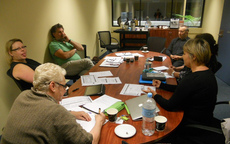
Emphasis was placed this week on the specifics of collaboration: group roles, logistics, administrative support, problem solving, and social marketing. While the last item may not seem to fit with those listed previously, it may be the most essential element to establishing a collaborative relationship between the librarian and the learning community. Can you see the woman in the picture to the left of her table, sticking her tongue out? Requests for collaborative meetings may be met with just that attitude, if the librarian has not established the social marketing process of AIDA: Attention, Interest, Desire, and Action.
So what does this mean for a brand new librarian like me? It means that when I am hired for a library position, I'm going to have to market myself and the library program. First, I'll have to gain the attention of my learning community through advertising. I'll have to get my staff, students, and parents interested in what the program has to offer by tuning in to their needs and those of the curriculum, making my skills and the services relevant, timely, and easy to access. Hopefully, this will lead to their desire to learn more about the services and utilize them. Desire will lead them to action--allowing me to collaborate with them, and eventually seeking out my skills and services without having to jump through the hoops of the AIDA process!
I may have to take the lead in starting the collaborative process, but that doesn't necessarily mean I will be the leader in collaborative groups. Roles change and are as varied as the teams who come together and the purposes they serve. Ultimately, though, the goal of every collaborative effort on a school campus is student engagement and achievement.
The two main hurdles to collaboration are time and administrative support. Using technology to support collaboration may help with time constraints. Convincing administrators to support my efforts to collaborate with the learning community may have me using that AIDA model yet again. Being confident in my skills, the library resources, and connecting with my "Why am I a librarian?" statement that we discussed in the I-DO Lead module will help guide me in fostering collaboration on my campus.
So what does this mean for a brand new librarian like me? It means that when I am hired for a library position, I'm going to have to market myself and the library program. First, I'll have to gain the attention of my learning community through advertising. I'll have to get my staff, students, and parents interested in what the program has to offer by tuning in to their needs and those of the curriculum, making my skills and the services relevant, timely, and easy to access. Hopefully, this will lead to their desire to learn more about the services and utilize them. Desire will lead them to action--allowing me to collaborate with them, and eventually seeking out my skills and services without having to jump through the hoops of the AIDA process!
I may have to take the lead in starting the collaborative process, but that doesn't necessarily mean I will be the leader in collaborative groups. Roles change and are as varied as the teams who come together and the purposes they serve. Ultimately, though, the goal of every collaborative effort on a school campus is student engagement and achievement.
The two main hurdles to collaboration are time and administrative support. Using technology to support collaboration may help with time constraints. Convincing administrators to support my efforts to collaborate with the learning community may have me using that AIDA model yet again. Being confident in my skills, the library resources, and connecting with my "Why am I a librarian?" statement that we discussed in the I-DO Lead module will help guide me in fostering collaboration on my campus.


 RSS Feed
RSS Feed